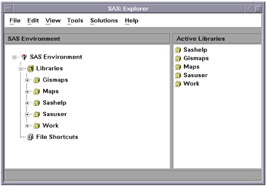SAS Windowing Environment in UNIX Environments
Introduction to the SAS Windowing Environment
You interact with SAS through windows using your keyboard, mouse, pull-down menus, pop-up menus , and icons. The windowing environment includes, but is not limited to, the Explorer, Program Editor, Output, Log, and Results windows .
Your SAS session may default to the windowing environment interface. If you want to use the windowing environment, you can start your SAS session as a foreground process or as a background process (by adding an ampersand (&) to your SAS command line).
For more information about using the windowing environment, see Chapter 2, "Working in the SAS Windowing Environment," on page 29.
| Note | If you are not using an X display, then you need to invoke SAS in interactive line mode using the NODMS system option. For more information, see "Interactive Line Mode in UNIX Environments" on page 7. |
What is the Explorer Window?
Explorer is a windowing environment for managing basic SAS software tasks such as viewing and managing data sets, libraries, members , applications, and output. The SAS Explorer is a central access point from which you can do the following:
-
manipulate SAS data through a graphical interface
-
access the Program Editor, Output, and Log windows (as well as other windows)
-
view the results of SAS procedure output in the Results window
-
import files into SAS.
What are the Program Editor, Output, and Log Windows?
The Program Editor, Output, and Log windows enable you to edit and execute SAS programs and display output. For more information about these windows, see SAS Help and Documentation.
Invoking SAS in the Windowing Environment
You can use the following commands to specify which windows open when the SAS session starts.
-
You can open the Explorer window by specifying the EXPLORER system option:
sas -explorer

-
You can open the Program Editor, Output, and Log windows by specifying the DMS system option:
sas -dms
-
You can use the DMSEXP system option to open the Program Editor, Output, Log, and Results windows and the Explorer:
sas -dmsexp
SAS also opens the toolbox from which you can open additional SAS windows. For more information about the toolbox, see to Chapter 2, "Working in the SAS Windowing Environment," on page 29.
Exiting SAS in the Windowing Environment
To end your SAS session, enter the BYE or ENDSAS command on the command line or select
File – Exit
from the pull-down menu of the session that you want to end.
EAN: 2147483647
Pages: 185